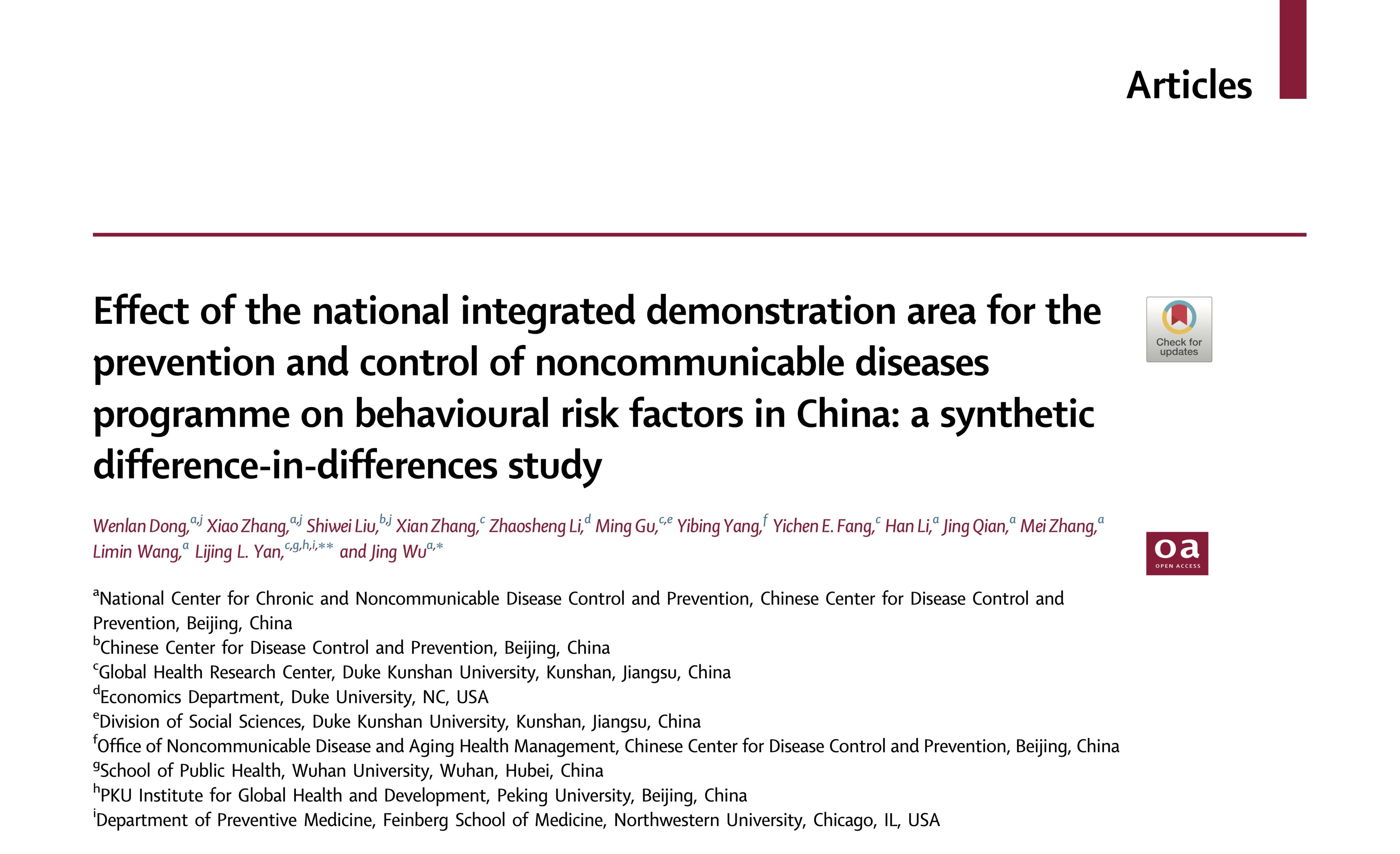Recent trends show a concerning rise in chronic non-communicable diseases (NCDs) in China, with death rates climbing from 80.0% in 2002 to 88.5% in 2019—exceeding the global average. In response, the National Health Commission launched the National Demonstration Areas for Comprehensive Prevention and Control of Chronic Diseases Program in 2011. This program aims to slow the incidence of chronic diseases, reduce related morbidity and premature mortality, and lessen the overall disease burden, ensuring comprehensive health protection for all.
The program achieves its goals by selecting and establishing demonstration areas, where local governments lead the implementation of multiple interventions. By 2020, 488 demonstration areas had been established across all 31 provinces, covering 17.1% of county-level areas and impacting 250 million people. Although some articles have provided preliminary analyses of the project’s progress and initial outcomes, a gap in nationwide evaluative evidence remains, challenging the assessment of these initiatives’ effectiveness.
On August 9, a breakthrough study led by Professor Lijing Yan from the Global Health Research Center at Duke Kunshan University, in collaboration with the Chronic Disease Center at the Chinese CDC, was published in The Lancet Regional Health—Western Pacific. The study, titled “Effect of the National Integrated Demonstration Area for the Prevention and Control of Noncommunicable Diseases Programme on Behavioural Risk Factors in China: A Synthetic Difference-In-Differences Study,” represents the first national-level assessment of the effect of implementations in the demonstration areas on residents’ health behaviors.
Professor Lijing Yan from Duke Kunshan University’s Global Health Research Center and Dr. Jing Wu, Director of the Chronic Disease Center at the Chinese CDC, served as the corresponding authors for the study. The research team also included Xian Zhang, a research fellow at the Global Health Research Center, Assistant Professor Ming Gu, and Yichen (Ethan) Fang, a recent graduate from Duke Kunshan University’s undergraduate program (Class of 2023).
Decreased smoking prevalence and alcohol consumption
The study included 26 demonstration areas (encompassing 72,193 residents) and 100 non-demonstration areas (encompassing 275,397 residents), utilizing the most recent five nationally representative surveys on chronic diseases and their risk factors in China from 2007, 2010, 2013, 2015, and 2018. The research assessed six behavioral factors among residents: current smoking, passive smoking, alcohol consumption in the past month, regular exercise, body mass index (BMI), and waist circumference*.
*Note: All six behavioral factors were weighted equally, with “regular exercise” assigned a weight of -1 due to its different directional impact. Lower behavioral risk scores indicate better overall outcomes.

“Chronic diseases are complex and often linked to a variety of risk factors, with lifestyle choices playing a key role. While some health initiatives focus narrowly on factors like smoking, the demonstration areas implement broad-based interventions involving cross-sectoral coordination led by local governments and social mobilization.” Explained by Professor Lijing Yan.
The study results indicated notable health improvements in demonstration areas compared to control groups. Specifically, there was a decrease in current smoking rates by 1.78% (95% CI: -4.51%, 0.96%), a reduction in passive smoking by 8.09% (95% CI: -14.27%, -1.90%), and a decline in alcohol consumption over the past month by 4.04% (95% CI: -8.75%, 0.67%). Results for regular exercise varied, and there were minor changes in body mass index (BMI) and waist circumference.

The study also assessed the effects of these interventions over various durations—short-term (1-2 years), medium-term (3-4 years), and long-term (6-7 years). It found that the overall behavioral risk score decreased by 1.05 in the short term (95% CI: -1.84, -0.26), by 1.15 in the medium term (95% CI: -2.08, -0.22), and by 2.82 in the long term (95% CI: -4.79, -0.85), with a total decrease of 1.54 (95% CI: -2.51, -0.56). These results suggest a positive and increasing effect of the interventions on residents’ behavioral risk factors from the short to long term.
Innovative Methods Overcome Challenges
The establishment of demonstration areas begins with applications from local governments, which are then reviewed and approved by the central government based on specific criteria. Assessing the effectiveness of such a large-scale public health project that has been implemented in the real world is not an easy task. Since the inception of the demonstration areas, evaluations of their implementation effects have been quite limited. A 2016 study, which relied on qualitative interviews and cross-sectional surveys, faced challenges in establishing high-quality causal inference evidence.

Xian Zhang explained, “Since demonstration areas must undergo a one- to two-year review process before approval, this policy does not fit into a randomized controlled trial design nor does it align with the assumption of parallel trends. Additionally, participants in demonstration areas typically have higher levels of education and income, creating systematic differences compared to non-demonstration areas. To address common analytical biases in such studies, we used an innovative method called ‘synthetic difference-in-differences study’ (SDID), constructing the first causal inference study based on the implementation of demonstration areas.”
“Our research provides high-quality scientific evidence for China’s largest and most prolonged chronic disease prevention project, which is of significant importance. It not only adds a scientific foundation to China’s efforts in controlling chronic diseases but also offers valuable insights for other countries and regions facing similar challenges,” stated Professor Lijing Yan.
The research team believes that interventions led by the government, involving cross-sectoral collaboration and community participation, are effective in promoting overall healthier behaviors. Integrating health interventions into all policy implementations, particularly those that modify environmental behavior factors like restricting the sale and consumption of tobacco and alcohol, has proven effective. However, interventions targeting individual behaviors, such as exercise and obesity, have not shown significant effects. Policymakers need to delve deeper into the causes and adjust relevant policies accordingly, such as providing more convenient public exercise facilities, increasing health education efforts, developing personalized intervention tools, or encouraging public participation through economic incentives like fitness subsidies.

Article By Ruitong Li (DKU UG Class of 2026)
For the full paper, click on the link: 10.1016/j.lanwpc.2024.101167


